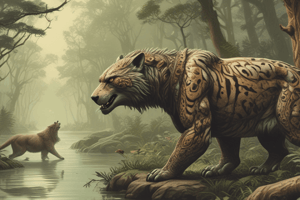Podcast
Questions and Answers
What will you explore in this assignment?
What will you explore in this assignment?
Common interactions among organisms.
Which organisms are considered predators? Check all that apply.
Which organisms are considered predators? Check all that apply.
- Organisms that eat animal carcasses (correct)
- Organisms that eat meat (correct)
- Organisms that eat plants
- Organisms that eat plants and animals
What are the three main weapons of predators?
What are the three main weapons of predators?
Claws, teeth, and jaws.
Identify the type of symbiosis described: The saguaro cactus provides food for the white-winged dove through its large fruit. The bird consumes the fruit, ingests the seeds, and then deposits the seeds in a new location.
Identify the type of symbiosis described: The saguaro cactus provides food for the white-winged dove through its large fruit. The bird consumes the fruit, ingests the seeds, and then deposits the seeds in a new location.
Identify the type of symbiosis described: The brown-headed cowbirds lay eggs in other birds' nests. They trick the birds into raising their young. The cowbirds hatch first and push the eggs out of the nest. The cowbirds are then fed by the nest-builder.
Identify the type of symbiosis described: The brown-headed cowbirds lay eggs in other birds' nests. They trick the birds into raising their young. The cowbirds hatch first and push the eggs out of the nest. The cowbirds are then fed by the nest-builder.
Describe the invasion of wild parsnip, including the harm it causes.
Describe the invasion of wild parsnip, including the harm it causes.
Describe how you can avoid spreading invasive plant species.
Describe how you can avoid spreading invasive plant species.
Flashcards are hidden until you start studying
Study Notes
Organism Interactions
- Explore common interactions resulting from relationships among organisms.
- Focus on five key interactions: predation, symbiosis, competition, commensalism, and parasitism, along with invasive species effects.
Predator Characteristics
- Predators consume meat, plants, animal carcasses, and may eat a combination of both.
- They play a crucial role in maintaining ecological balances by controlling prey populations.
Predator Weapons
- Three main predatory tools are:
- Claws
- Teeth
- Jaws
Mutualism Example
- Saguaro cactus and white-winged dove interaction exemplifies mutualism.
- Cactus provides food through large fruit, supporting the dove.
- Dove aids cactus by dispersing its seeds to new locations.
Parasitism Example
- Brown-headed cowbirds exhibit parasitism by laying eggs in other birds' nests.
- They manipulate host birds into rearing their young while pushing out the original eggs.
- This relationship benefits cowbirds significantly at the expense of host birds.
Invasive Species Impact
- Wild parsnip can dominate landscapes, reducing biodiversity by outcompeting native flora.
- Contains chemicals that increase skin sensitivity to sunlight, causing severe dermatitis.
Prevention of Invasive Species Spread
- To avoid spreading invasive species:
- Remove seeds from clothing after outdoors activities.
- Dispose of seeds at home properly instead of discarding them outside.
- Check pets for seeds after outdoor use.
- Adhere to trails while hiking to avoid plant dispersal.
- Use local firewood to prevent transportation of invasive species.
- Inspect boats, trailers, and outdoor equipment for seed attachment.
Studying That Suits You
Use AI to generate personalized quizzes and flashcards to suit your learning preferences.




